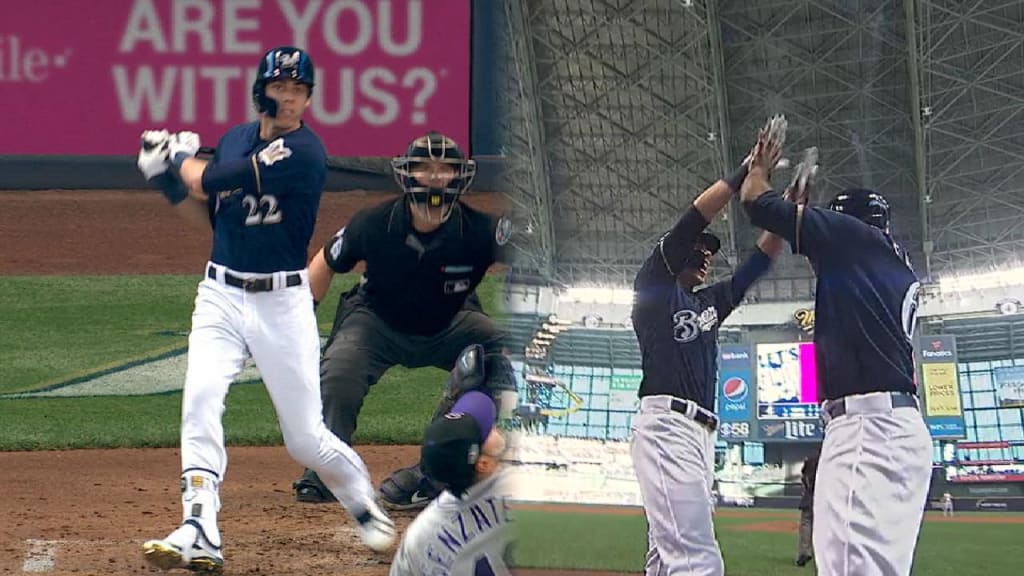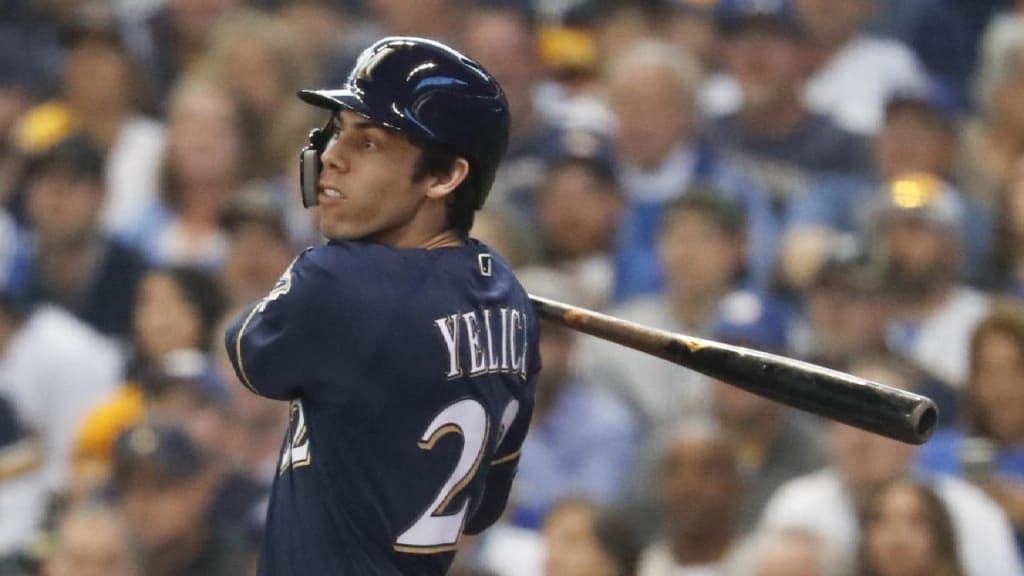Yelich not distracted by launch-angle talk
This browser does not support the video element.
MILWAUKEE -- Two summers ago, Christian Yelich sat in the visitors' clubhouse at Citi Field in New York on something of an ideological island. It had been more than a year since Statcast™ introduced launch angle as a concept, providing a public metric to a movement that had been building behind the scenes for years: hitters overhauling their swings to defy shifts, increase slugging and, above all else, get the ball in the air.
Suddenly, successful launch-angle acolytes were grabbing headlines across baseball: Justin Turner raking in Los Angeles, Daniel Murphy transforming into a power threat in D.C., Josh Donaldson all but planting a fly-ball flag north of the border. From the outside, many pegged Yelich as a prime candidate to buy in. The former first-round Draft pick was hitting for power for the first time at age 24 (he'd end up with 21 homers, triple his total from the previous year), but still sported one of the highest ground-ball rates in the game.
:: NLDS schedule and results ::
It wasn't difficult to see Yelich's athletic build and compact swing and project more. He didn't disagree. But Yelich also didn't feel comfortable with the mechanical leap of faith -- and perhaps a seed of doubt -- that seemed required to tap into it.
"OK, but how do you do that? It's not swinging up," Yelich said. "If you're not strong enough, launch angle is not your friend."
For more than 20 minutes that day, Yelich explained in detail why, despite outside pressure, he'd resolved to stay the course. He didn't deny the data, but disagreed with the wholesale approach. Yelich saw the launch-angle revolution as "a trend," rather than as a sustainable model for success or the cure-all solution it was often branded as being. He didn't see how his specific swing fit in, didn't like the bad habits that might result from the change. And Yelich saw strikeout rates rise along with home runs, and pitchers beginning to pepper the top of the strike zone with fastballs. He saw traps. His hitting coach, Barry Bonds, the all-time home run champion, counseled patience, not overhaul. Yelich listened.
Yelich would've been at a crossroads had he not been full of conviction that, given time, he would blossom in his own way, on his own terms.
"I could talk about this all day," Yelich finally said, strapping on his batting gloves. "But I have to go hit."
This browser does not support the video element.
Reminded of that conversation this week at Miller Park, Yelich reported nothing different in his approach. But the numbers tell a slightly different story. And in the gray space between them and Yelich's words lies the nuance rarely afforded in most launch-angle debates, where, Yelich says, "everybody is either on one extreme side or the other."
There was no "a-ha" moment, Yelich said, no winter he spent purposefully looking to launch. Instead, he sees his breakout 2018 season as the result of a stream of incremental adjustments, that, in the aggregate, morphed him into a slugger all the same.
In Yelich's mind, the elevation came organically. Though his average launch angle (4.7 degrees) remains one of the lowest in baseball, it more than tripled (from 2.5 degrees to 8.3 degrees) over this season's final two months, when he hit .335/.434/.728 with 21 home runs to emerge as the National League MVP Award front-runner. Balls struck at more than 100 mph also tripled in launch angle over that span, from just north of five degrees, on average, to more than 15 degrees. Yelich barreled balls at a career-best 12.9 percent rate in 2018, good for sixth among NL hitters. His hard-hit line drive/fly-ball rate soared to a career-best, and his ground-ball rate sank to a career low.
And yet his intent, Yelich says, was never to yank. It still isn't.
"There has been no conscious change on my part, no buying into launch angle," Yelich said. "I stuck with what I've been doing my entire career, with a few adjustments -- but focusing on launch angle was not one of them. There were some, but that wasn't one of them."
In Miami, Bonds and assistant hitting coach Frank Menechino tutored Yelich on the importance of body position and timing. They focused on getting Yelich in a better position to drive the ball while keeping his swing relatively the same. In Milwaukee, hitting coach Darnell Coles stressed attacking the ball more out in front, particularly outside pitches, which Yelich had a tendency to spray the other way instead of drive with authority.
"Everybody is starving for guys to say they want to hit a fly ball all the time, but it's never once crossed my mind," Yelich said. "I've never once gone up there thinking, 'Let me roll this ball over and hit a 12-hopper.' I'm not saying that, either. But there is a way to have your misses give you a chance, as opposed to having your misses give you no chance."
This browser does not support the video element.
In doing so, Yelich did what many launch-angle acolytes could not: added power without sacrificing swing-and-miss while maintaining an all-fields approach. His strikeout rate and OPS with two strikes stayed essentially unchanged in 2018. Twenty-one of Yelich's home runs went to the center of the field, more than any other player in baseball. His pull rate increased, but at 31.3 percent, didn't sniff his career-high. Yelich rarely faces shifts, despite being left-handed and leading NL hitters in slugging percentage.
"He understands himself," Coles said. "His foundation is such that he knows what he wants to do, he knows how he wants to do it, and then it's just executing."
That execution popped up in nearly every part of Yelich's offensive game. He swung at more first pitches (29 percent, compared to 19 percent in 2017) to great success (1.178 SLG in 2018, 427 points beyond his career mark). Yelich hit fastballs better than ever (.356 average against them, second among NL hitters), and improved mightily against offspeed pitches (.286/.293/.571, compared to .216/.245/.330 in 2017).
All told, Yelich will lead the Brewers into Game 3 of the NL Division Series against the Rockies on Sunday in Denver as one of baseball's most complete hitters, a star in a postseason alongside Turner, J.D. Martinez and other launch-angle advocates.
This browser does not support the video element.
Yelich said he feels vindicated in his approach, and in there being no wide mechanical gap between him and those sluggers.
"Take a snapshot of all the best hitters at contact, you'd see they all get to the same place. The difference is the mindset. What you tell yourself to get there," Yelich said. "Some guys tell themselves to swing up, some guys tell themselves to swing down. But they all get to the same place.
"There is no one way to hit. There are guys who are all in on the launch angle and have been successful, and guys who aren't who are also successful. Both of us are right, but there is a way to meet in the middle. I'm trying to be in the middle."

